So. We lost the great Denny O’Neil this week.
I don’t know what i can add to the conversation that’s already out there about what a amazing writer and editor he was, and how much he contributed to comics as an industry and the culture as a whole. People who knew him better have already said more than I can ever say.
Instead, I thought we ‘d take a couple of weeks to focus on the character where I think Denny O’Neil’s voice can best be heard, even more so than on Batman: Oliver Queen, the Green Arrow. We’ll really focus on Denny’s work with Ollie next week, but in the meantime, let’s start at the beginning.
I think I’ve mentioned previously my fondness for the line of Marvel and DC superhero action figures produced by Mego in the 1970s. Hollow plastic 8-inch dolls dressed in actual cloth outfits and capes, the figures had a distinction of design theory that I admire to this day. Not every character worked well in this format: the Thing, for example, sported a stretchy unitard over his bulky frame (borrowed from the mold used for the Hulk figure) with his trademark rocky skin printed on it. Pretty sad. But when it worked, it worked amazingly well. Case in point: Mego’s Green Arrow figure, which still stands out as probably the best-looking release in Mego’s entire superhero line.
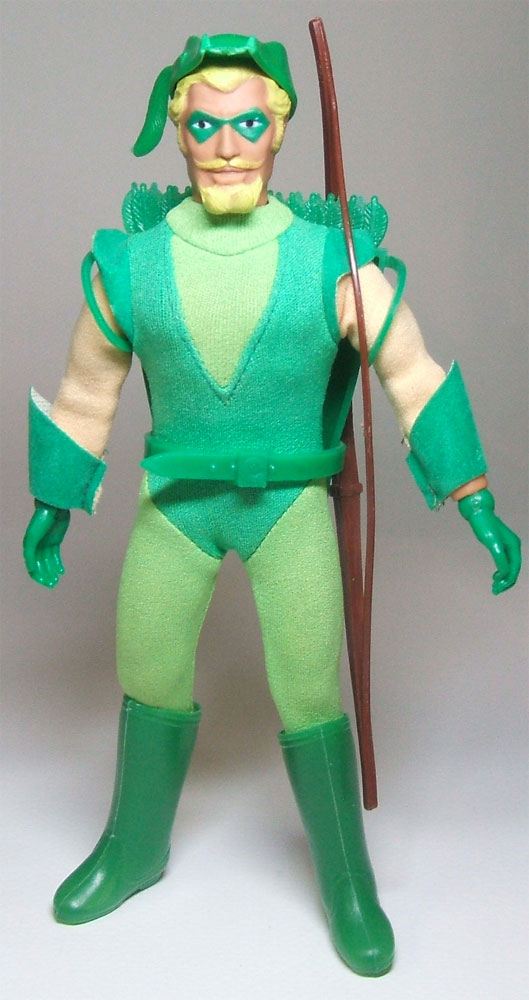
The sheer coolness of this figure is most likely the genesis of my lifelong affinity for the Green Arrow, DC Comics’ archer in residence. While primarily known as a team player through his appearances in JUSTICE LEAGUE OF AMERICA and the landmark GREEN LANTERN/GREEN ARROW issues of the 1970s, G.A. has also held the spotlight on his own from time to time, with varying degrees of success. With Green Arrow making headlines these days both in his own comic and in the pages of JUSTICE LEAGUE OF AMERICA, not to mention every week on the CW, what better time to peruse the publishing history of one Oliver Queen? Off we go.
The Green Arrow, along with his sidekick Speedy, first appeared in the November 1941 issue of MORE FUN COMICS. Created by National Comics writer/editor Mort Weisinger and artist George Papp, Green Arrow and Speedy seemed to be pretty obviously modeled on the massive success of Batman and Robin, taking the same basic dynamic and grafting the archery gimmick onto it.

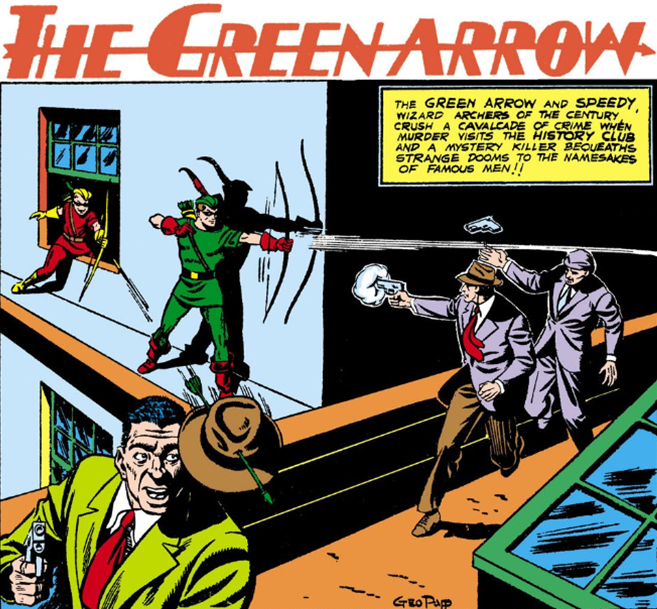
In later years, Weisinger denied that Batman played any part in the creation of Green Arrow, claiming in the 1976 book SECRET ORIGINS OF THE DC SUPERHEROES that “I wasn’t remotely influenced by Batman. My Green Arrow was a streamlined Robin Hood — a law-abiding Robin Hood. Then I added props — the Arrowmobile, for one, and I got into the business of creating new kinds of arrows.” To be honest, Mort, listing the Arrowmobile in your defense wasn’t doing you any favors.
Even the most generous eye can see that the Batman/Green Arrow parallels are pretty obvious. Aside from Oliver Queen being a rich dilettante with a young ward who fights crime, the fact that Green Arrow drove an Arrowmobile and flew an Arrowplane, had a hall of trophies in the Arrowcave, and by 1947 was even being summoned by to Police Headquarters with a flaming Arrowsignal — well, let’s just say imitation is the sincerest form of flattery and leave it at that. However, early on, most of these Batmanesque gimmicks were yet to be incorporated. As for an origin story, this thankfully was not lifted from Batman, although as motivations go, it is admittedly a little thin. In fact, it was something of an afterthought, appearing almost a year and a half after Green Arrow and Speedy’s first appearance, in MORE FUN #89 (March 1943).
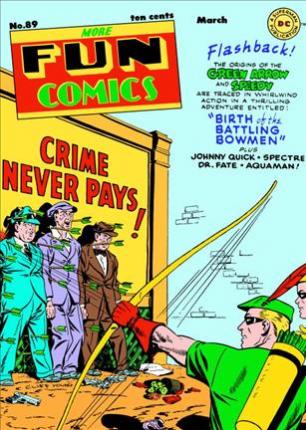
In “The Birth of the Battling Bowmen,” written by Weisinger and drawn by Cliff Young and Steve Brodie, Green Arrow and Speedy reminisce about how they first met some years before. It all began when young Roy Harper was marooned on Lost Mesa, along with his family’s Indian servant Quoag, when Roy’s father crashed their plane atop the remote mesa. Roy’s father died in the crash, but Roy and Quoag survived, and the two were able to survive, and even thrive, with Roy developing a remarkable skill at archery, enabling them to hunt wild game.
Roy and Quoag lived in solitude on Lost Mesa for years, before being discovered by a plane, which was heading for the Mesa due to a misunderstood remark from the mouth of one Oliver Queen.
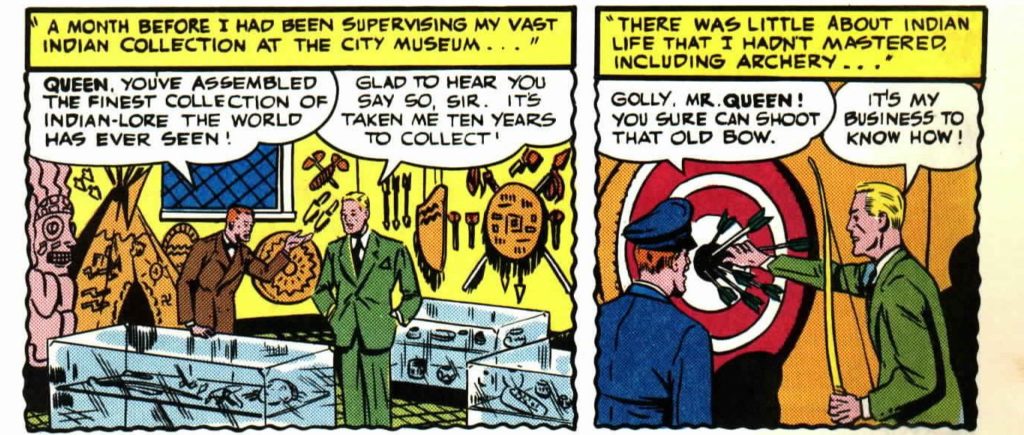
As it happened, Queen, an expert on American Indian culture and lore (including, naturally, archery), had recently lost his entire collection of artifacts when, while foiling a robbery attempt at the museum, errant gunfire set off a fire that burned everything to the ground. Despondent, Queen is consoled by the museum’s curator, who urges him to rebuild by going back to archaeology, exploring the Indian remains at Lost Mesa, which is supposed to be a “hidden gold mine” of artifacts.
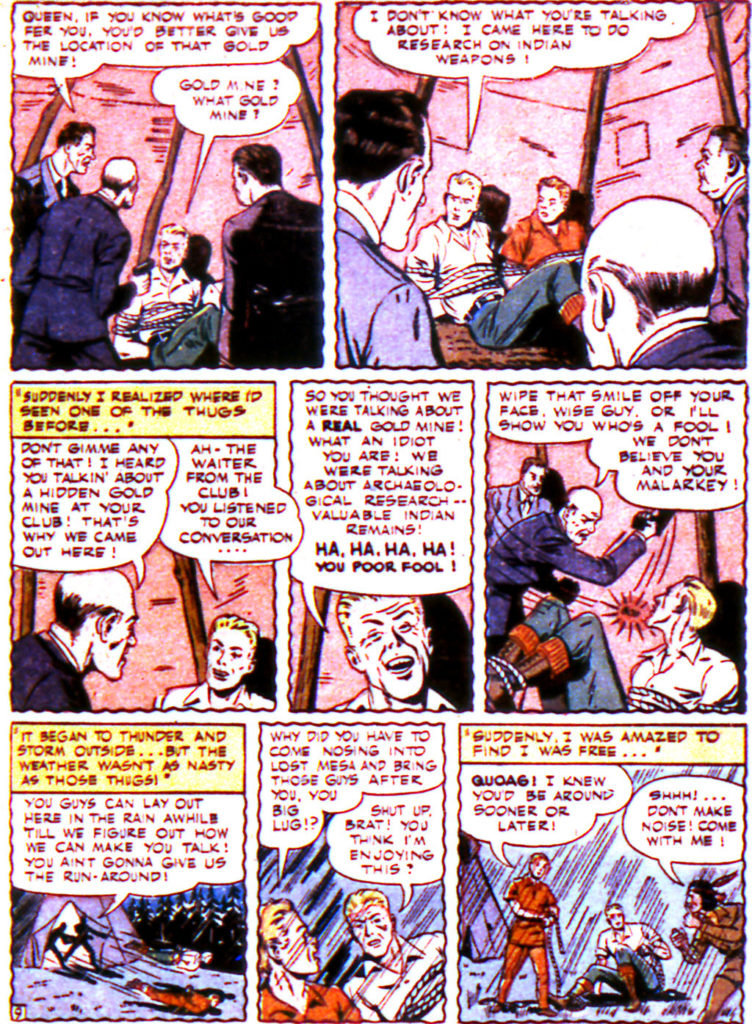
Unfortunately, this remark is overheard by a crooked waiter, who apparently gathered a gang of thugs (perhaps from the lunch shift) and headed for Lost Mesa to beat Queen to the gold. The criminals accost Quoag and Roy, who manage to fight them off and escape, only to discover Oliver Queen landing his own plane. Thinking he’s with the criminals, Roy attacks Oliver, only to be captured by the evil armed waiter. Queen recognizes the waiter and explains that there’s no gold, that it was merely a figure of speech, but the waiter isn’t buying it, and ties Oliver and Roy up to be interrogated. Quoag frees Oliver and Roy and leads them to nearby caves where he’s stashed bows and arrows, but takes a bullet in the process.
Armed and ready for action, Oliver and Roy follow the air currents to discover a back way out of the tunnel, and in the process discover, wouldn’t you know it, a hidden gold mine! Ah, coincidence is a harsh mistress. While Oliver and Roy fight off the thugs with their arrows, Roy quickly dashes out to attack one in person, then darts away, prompting the thug to remark “Boy, that kid’s speedy!” Seconds later, another thug is heard warning his friends: “Watch out for the big guy. He shoots a mean green arrow!” Not exactly “I shall become a bat!” but I guess it’ll have to do…
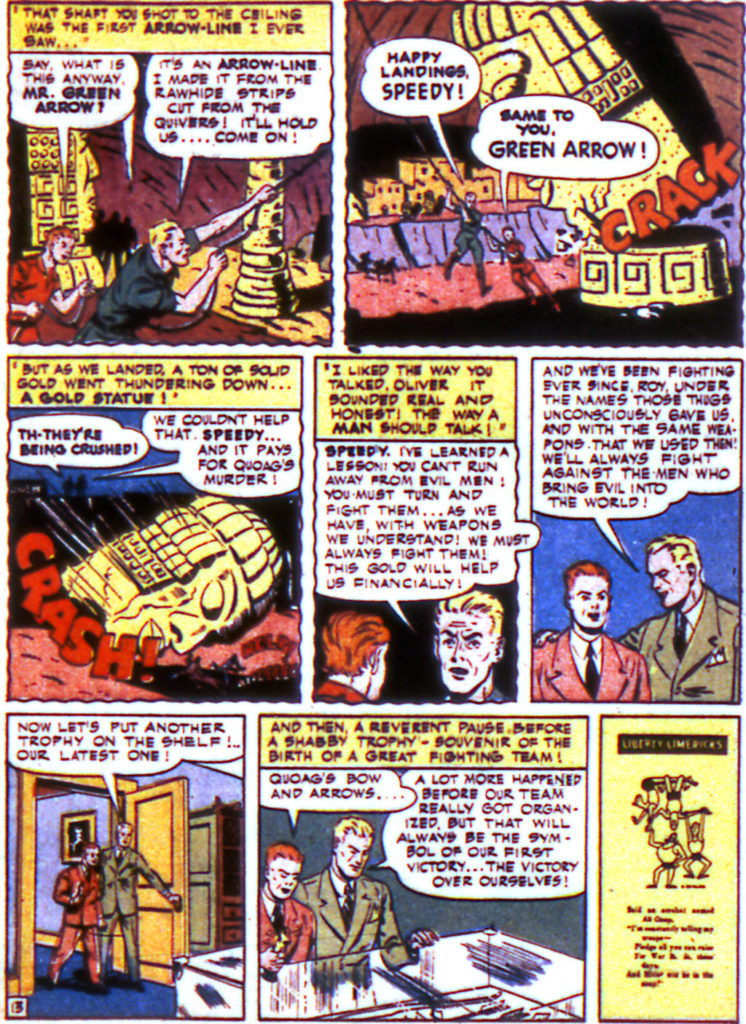
Oliver quickly makes the first “Arrowline,” attaching a makeshift rope to an arrow, and uses it to swing down to safety. The impact of their landing causes the nearby giant gold idol to crash to the ground, conveniently crushing the evil waiter and his pals.
Inspired by this bit of righteous carnage, Oliver and Roy decide to fight evil “with weapons we understand!” Claiming the native American gold for their own (because, hey, they’re white guys and this is America), Oliver and Roy use their newfound wealth to begin their crimefighting careers as Green Arrow and Speedy.
Over the years of Green Arrow’s run in MORE FUN, his array of “trick arrows” were developed, including the aforementioned “arrowline” to allow him to swing from the rooftops, as well as the net arrow, the drill arrow, the smoke arrow, the boomerang arrow and of course, the all-time favorite, the boxing glove arrow.
At the height of their Golden Age popularity, Green Arrow and Speedy could be found both in MORE FUN COMICS and as a regular feature in WORLD’S FINEST. Even more exposure followed in 1942, when Green Arrow and Speedy joined up with a National Comics superhero team. Sadly for them, it was not the wildly popular Justice Society of America…
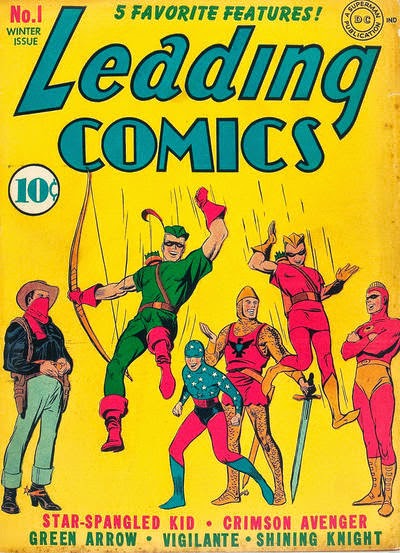
In a classic “big-fish-in-a-small-pond” scenario, Green Arrow and Speedy were the biggest names in National Comics’ minor-league super-team, the Seven Soldiers of Victory, which had a less-than-stellar 14-issue run in LEADING COMICS, from 1942 through 1945. The Seven Soldiers (also known as the Law’s Legionnaires) consisted of Green Arrow and Speedy, the patriotic heroes Star-Spangled Kid and Stripesy, the transplanted Arthurian warrior the Shining Knight, the Crimson Avenger (with his sidekick Wing occasionally joining in as an unofficial eighth member), and the motorcycle-riding singing cowboy the Vigilante.
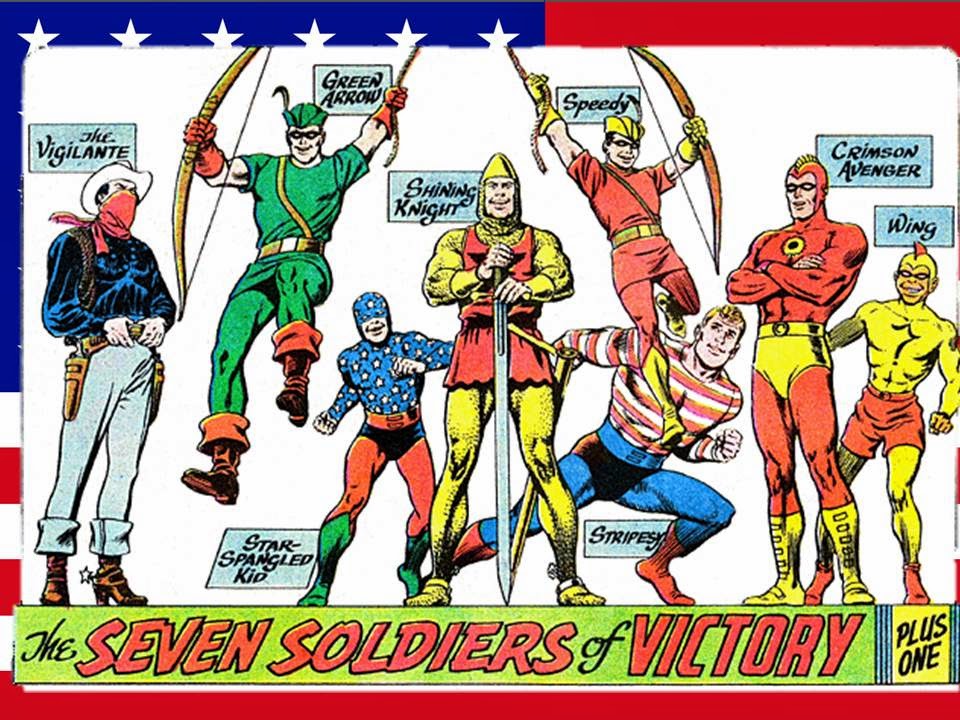
With its decidedly unremarkable roster and equally dull stories, the Seven Soldiers never really caught on, and is nowadays little more than a footnote in DC history.
Through the 1940s and into the ’50s Green Arrow continued to appear regularly, first in MORE FUN and WORLD’S FINEST, then settling into a long run in ADVENTURE COMICS, starting in 1946. Most of these stories were pretty standard fare, focusing mostly on Green Arrow and Speedy using their ever-expanding arsenal of gimmick arrows against interchangeable thugs, bandits and crooks; nothing spectacular, but certainly not awful. The character got a much-needed shot of vitality in 1958, when comics legend Jack Kirby took over the strip, penciling the book (with a rare appearance by Jack’s wife Roz handling the inking duties) and contributing heavily to the plotting. Kirby’s Green Arrow was much more dynamic, and far less formulaic. Suddenly, Green Arrow and Speedy were traveling to other dimensions and meeting alien archers inspired by their exploits, and convening meetings of the “Green Arrows of the World,” crime-fighting archers from around the globe who modeled themselves after Oliver Queen. The best-remembered and most influential story from Kirby’s GREEN ARROW run was Kirby’s last, from ADVENTURE COMICS #256 (January 1959): “The Green Arrow’s First Case.”
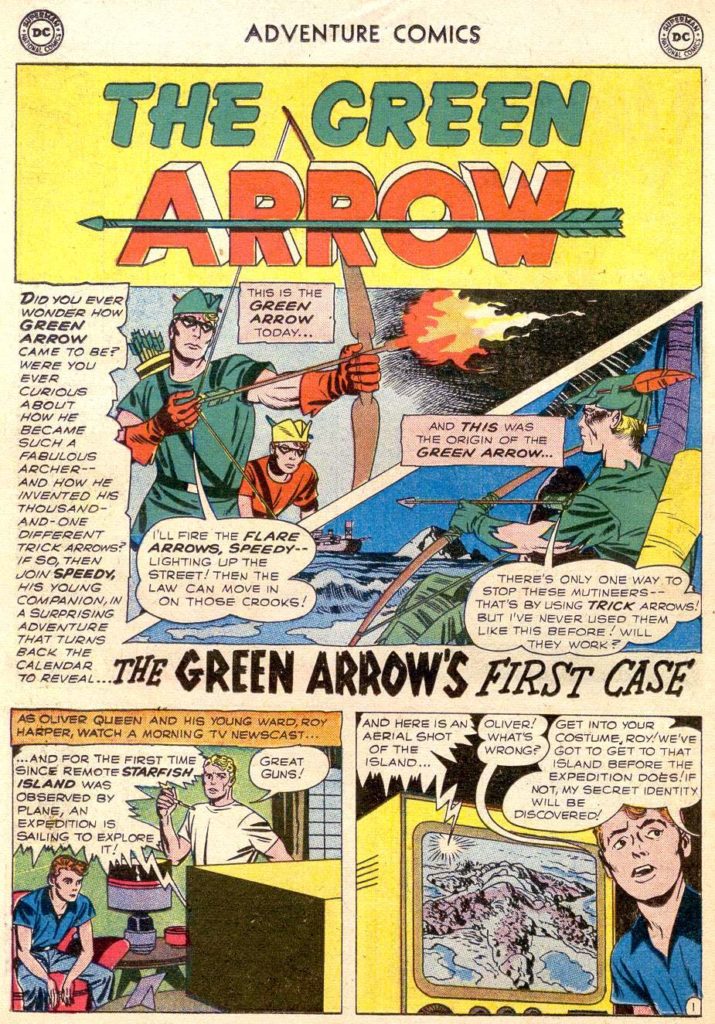
An all-new version of Green Arrow’s origin story, the tale begins with Oliver and Roy rushing via Arrowplane to arrive at remote Starfish Island before an announced group of explorers, in order to save Oliver’s secret identity. Oliver explains that, years ago, a younger, wealthy and idle Oliver Queen was on a voyage to the South Seas when he fell off the ship. Just fell off. Whoops. Right overboard. That’s drama for you. Anyway, Oliver manages to swim the aforementioned Starfish Island, where he’s forced to teach himself to use a bow and arrow in order to survive.
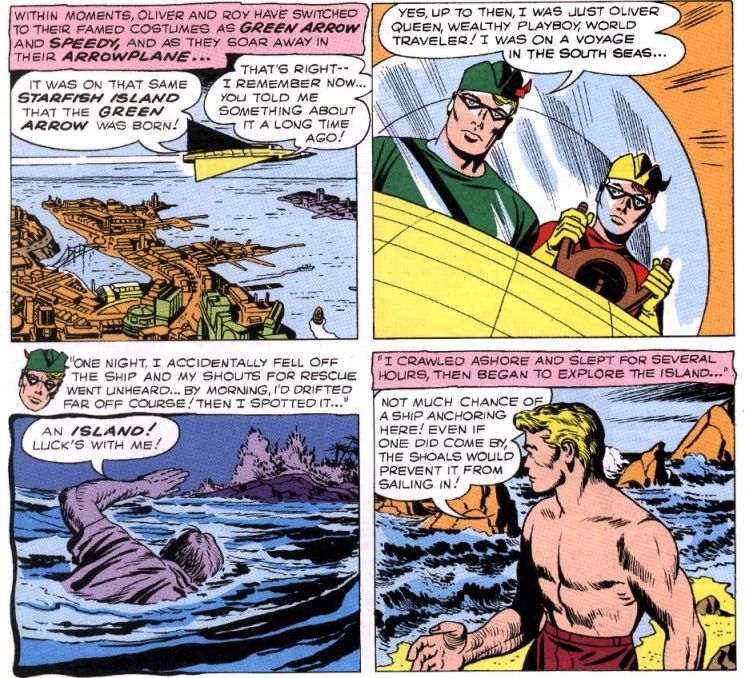
In order to catch fish, he creates his first “rope arrow,” and when that proves too time-consuming, he invents a crude “net arrow” from vines and hollow reeds, allowing him to catch schools of fish. Looking for something to drink with his fish, Queen figures out how to bring down coconuts from the trees thanks to his “drill arrow,” devised with the help of the elastic band from his socks. The bored Ollie kept records of all of this, chiseled into a stone wall (hence the modern-day Green Arrow’s rush to get there before the explorers do).
Fashioning a green costume for himself with leaves and foliage in order to sneak up on small game, Oliver Queen had settled into a spare but survivable existence on the island. That is, until the day he spotted a commercial freighter passing by, thanks to the sound of gunfire. Ollie swims out to the ship and climbs aboard, to discover that part of the crew had mutinied.
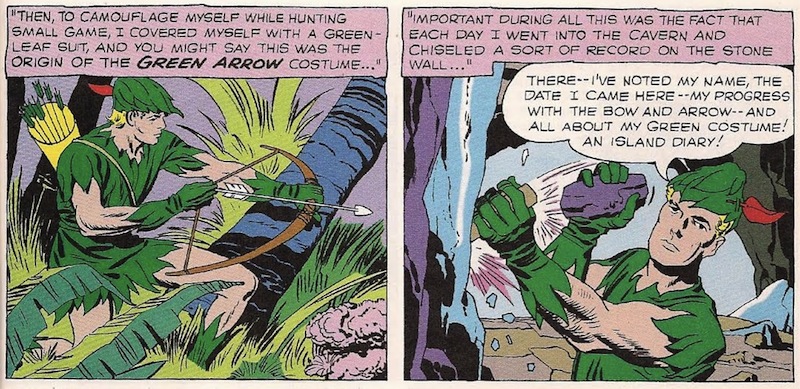
Looking to stop the mutineers (presumably so they don’t kill him along with the captain), Ollie smears grease from the anchor chain on his face as a crude camouflage (his first time wearing a “mask”), and fires off a drill arrow at some nearby oil barrels, preventing the mutineers from charging him. Ollie then lets fly with the net arrow, and the mutineers are out of action. In answer to the captain’s grateful questions, Ollie replies only, “Just call me Green Arrow.”
Back in the present, Green Arrow manages to scare off the explorers thanks to his conveniently present “Fake-Uranium Arrow” (honest to God — you can’t make this stuff up), which tricks the explorers into believing the island contaminated due to nearby nuclear tests. The expedition heads back to the boat right quick, and Ollie’s secret is secure. Kirby’s run on GREEN ARROW was short-lived, and soon the series was back to the predictable, gimmick-heavy status quo. Those of you curious about Jack Kirby’s brief dalliance with the Emerald Archer can pick up THE GREEN ARROW BY JACK KIRBY, a 2001 softcover that reprinted all 11 Kirby adventures. Fun comics featuring some primo Kirby art, and a real bargain at $5.95.
Despite the routine nature of his adventures, it must be noted that, thanks to his spot tucked away in the back of ADVENTURE COMICS, Green Arrow was one of only two superheroes (Aquaman, also an ADVENTURE feature, being the other one) without their own series to remain in continuous publication since their inception. When the superhero craze crashed in the late 1940s, Superman, Batman and Wonder Woman survived, but every other superhero National published vanished into history — except for Green Arrow and Aquaman. It was probably this longevity that later played into Green Arrow’s favor in 1961, (superheroes being once more all the rage), when the newly popular Justice League of America named him as their first new recruit, in JUSTICE LEAGUE OF AMERICA #4, “The Doom of the Star Diamond.”
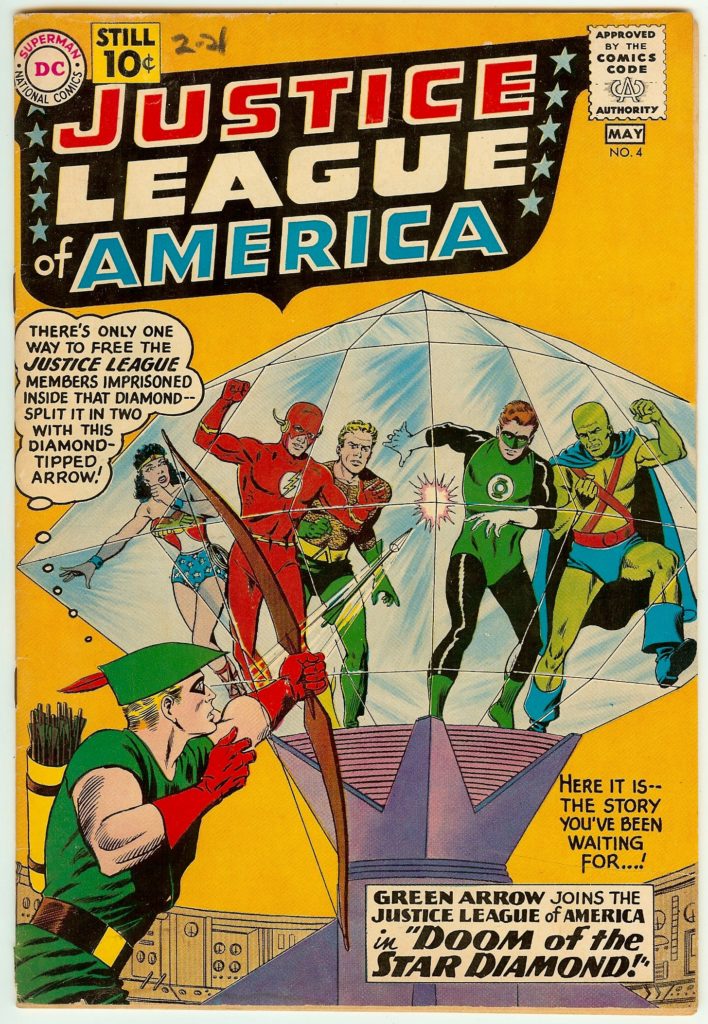
In the story, written by Gardner Fox and drawn by Mike Sekowsky, an exceptionally jovial Justice League is deliberating the matter of whom they should offer membership to, finally nominating Green Arrow’s name for a vote.
Little do they suspect that an alien outcast named Carthan, exiled to Earth in a political coup, has already kidnapped Green Arrow to use as bait, hoping to involve the Justice League in a circuitous plot to grant him his freedom. Carthan’s not really a bad guy, it turns out, and when the League manages to undo the mechanisms keeping him on Earth, he keeps them prisoner in an unbreakable diamond cell until he can explain himself. Unfortunately, a skirmish with Batman damages the cell controls, and the League is trapped in the cell forever, unless Green Arrow can strike the diamond cell’s stress point with one of his diamond-tipped arrows.
Fortunately for the League, Green Arrow is just that damned good. The freed Justice League members waste no time in making it official, and Green Arrow is elected and granted full membership in the Justice League of America.
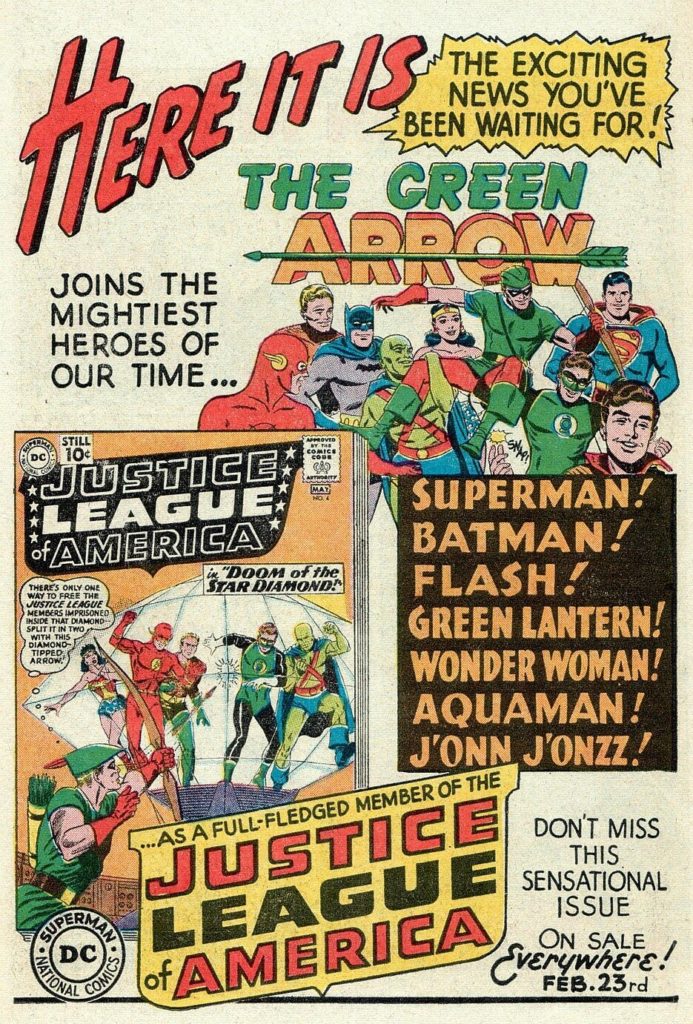
It was a good thing, too, because only the year before, Ollie had lost his spot in ADVENTURE and by 1964 his feature in WORLD’S FINEST would be discontinued as well, leaving his appearances in JLA the only thing keeping him in the public eye.
Green Arrow appeared in practically every issue of JUSTICE LEAGUE OF AMERICA for the next seven years, and when Denny O’Neil took over the writing duties with issue #66, all of a sudden Ollie had more personality than he’d displayed in the past two decades, speaking up at a JLA meeting about what he perceived as the League’s lack of commitment to the needs of the common man.
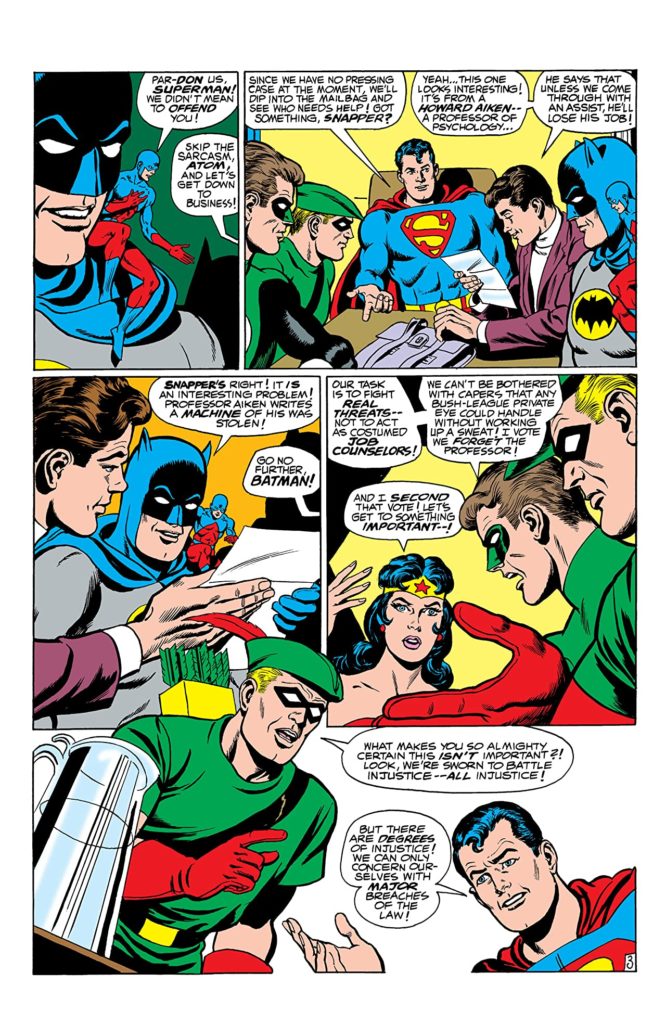
This was just the first of many changes in store for Green Arrow, changes that would form the basis of the character as most people still think of him to this day. But that’s a story for another column…

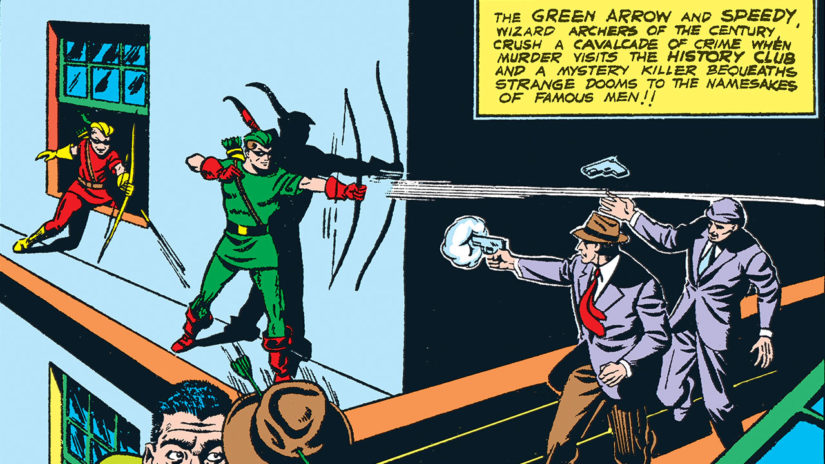
Comments are closed.